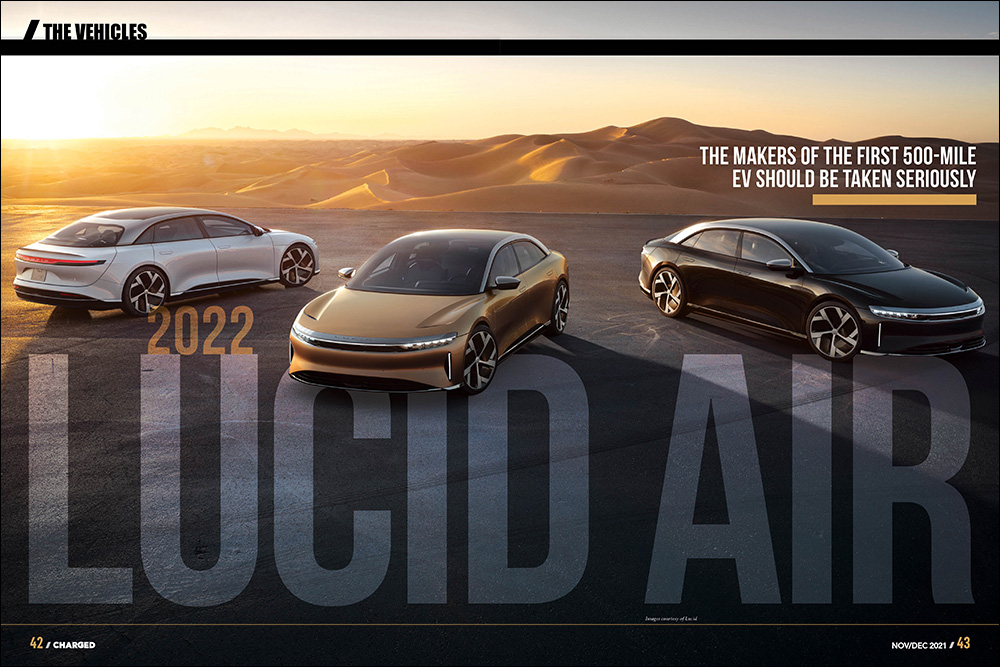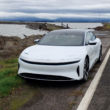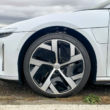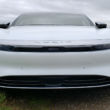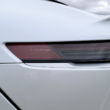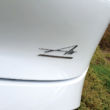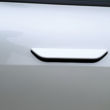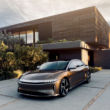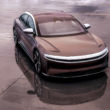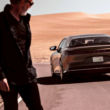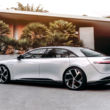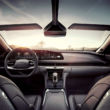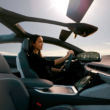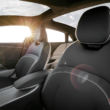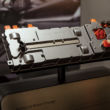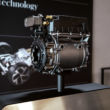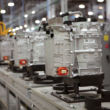Created by engineers with years of EV experience, the 2022 Lucid Air is a stunning debut that confronts Tesla—and Mercedes-Benz—with a new competitor.
It’s been a long time coming, but the 2022 Lucid Air has been worth the wait. The new carmaker’s all-electric luxury sedan not only competes directly with the aging Tesla Model S, but also with the brand-new Mercedes-Benz EQS. And Lucid’s Dream Edition Range model includes a feature neither can offer: 520 miles of EPA-rated range, the highest among the dozens of EVs on sale for 2022.
Lucid execs say making an all-electric competitor for the classic Mercedes S-Class was always the goal—they politely dismiss the idea that the Model S would be any kind of target. In that light, it’s worth noting that Lucid CEO Peter Rawlinson was Lead Engineer on the Model S more than a decade ago.
As one Lucid exec told this reporter several years ago (after a guarantee of anonymity), “We think we can do the same thing Tesla did—but better.”
Lucid execs say making an all-electric competitor for the classic Mercedes S-Class was always the goal—they politely dismiss the idea that the Model S would be any kind of target.
Photos courtesy of John Voelcker
Smaller outside, bigger inside
The dimensions of the 2022 Lucid Air are hard to peg from the outside. In Mercedes terms, the company says, it has the (mid-size) footprint of an E-Class sedan, but the wheelbase and the cabin space of a (full-size) S-Class. Indeed, the Air’s short nose and tail, minimal overhangs and long wheelbase give it distinctively different proportions than a gasoline luxury sedan. Crucially, though, it doesn’t look “weird,” and many buyers may never be able to articulate quite why it looks different.
These days, gold is a car color irretrievably associated with the Rad Era (often seen in old-lady Lexus models). With contrasting silver roof edges, however, Eureka Gold works so well on the Air sedan that it’s the signature color of the Dream Edition launch version. A deep lustrous maroon metallic, also with silver pillars, is Lucid’s other distinctive color—and it’s stunning. Inside, the buyer has a choice of interior themes (“looks,” really), each intended to evoke a different sort of luxurious environment. The 520 launch Dream Editions, for instance, get “Santa Monica,” which blends perforated Nappa leather, Alcantara, buffed metal and open-pore eucalyptus wood.
Derek Jenkins, Lucid’s Senior Vice President of Design and Brand, suggested the entire goal was to be “calming,” providing a sublime elegance that relaxes drivers and passengers rather than facing them with new and unfamiliar ways of interacting with the car. In other words, yes, the Lucid Air has some switches and knobs: not every single function is controlled through a central touchscreen. Other executives echoed Jenkins’s quiet elegance theme, using phrases like trying not to be “tacky” and contrasting to other luxury cars that were “a bit shouty.”
Capacious cabin, optional foot garages
The cabin space is large, though it doesn’t feel particularly expansive due to its low height. Inside, the glass roof gives an open feeling—its single-piece glass windshield actually reaches from the cowl all the way up to past the driver’s head, a triumph of elegance. Lucid, however, has managed to provide proper sun visors, unlike the peculiar unfolding Tesla Model X units intended to solve the same problem with a similar piece of glass.
Its single-piece glass windshield actually reaches from the cowl all the way up to past the driver’s head, a triumph of elegance.
Still, legroom is generous front and rear. The rear seat is slightly more pleasant in the lower-range model, which deletes a couple of battery modules to provide depressions in the floor that give added footwell space (now universally known by the delightful German term foot garages).
Other makers can do luxury, including Mercedes, which has been first among high-volume luxury brands for decades. It seems safe to say the Air and the new EQS are roughly on a par in materials and quality, but the EQS offers more features (five separate types of massage built into each front seat, as just one of many examples).
Efficiency in every aspect
It’s the care and attention to efficiency in every part of the car’s drivetrain that sets the Lucid Air apart. Consider the specs for the high-end, all-wheel-drive models of each of the three competitors.
Tesla’s Model S Long Range has the smallest battery capacity of the three, at 100 kWh, from which it extracts 405 miles of combined EPA-rated range. The Mercedes-Benz EQS 580 4Matic has a bigger battery, at 120 kWh (108 kWh usable), but less range: 340 miles. The Air’s battery capacity is 118 kWh—both gross and usable, Lucid says. How does that work? “Lucid has the hardware and software expertise to use the full energy of the battery while preserving battery life and fast charging performance in hot and cold climates.” In other words: “We’re not saying.”
In comparison to the Mercedes-Benz EQS, the Lucid battery has 9 percent more capacity—yet it produces a range rating of 520 miles, or 53 percent more.
In comparison to the Benz, the Lucid battery has 9 percent more capacity—yet it produces a range rating of 520 miles, or 53 percent more. Similarly, the Lucid has 18 percent more battery capacity than the Tesla, but 28 percent more range. Viewed as a ratio of rated range to battery capacity, Lucid delivers almost 9 percent more than Model S and a whopping 40 percent more than the Benz.
During an interview with CEO Rawlinson in mid-2020, when the company first projected a rating of 500-plus miles, he returned again and again to the engineers’ obsessive focus on efficiency. A two-year hiatus from 2017 through 2019, while Lucid sought funding to build its Arizona factory and put the Air into production, gave engineers the chance to make several more iterations of the power unit in particular.
Over the break, engineers doubled the battery voltage from the standard 400 volts. It’s now rated at 800-924 volts. That in turn permitted use of ultra-fast DC charging at more than 250 kW—as pioneered by Porsche, and still offered by only a handful of EV makers (including Hyundai-Kia). The Lucid also has bidirectional charging, providing up to 10 kW of output through the company’s home charging station. The company will provide buyers with 3 years of free DC fast charging through the Electrify America network.
While the Lucid Air itself is just going into production, the company’s engineers have deep experience extracting maximum performance from battery packs under the toughest conditions. Lucid’s technology division, Atieva, has built the batteries used in the standard-spec Formula E electric race cars for several years now, and has all the data on how they performed. No other startup EV-maker beside Tesla is likely to have that depth of understanding of how its cells perform under extreme conditions.
Lucid Inside in future?
Other innovations from that period include reductions in the size of the power unit, which comprises the electric motor, power electronics and gearing. That unit may well be sold to other makers, execs hinted in November, perhaps offering a kind of “Lucid Inside” branding on far higher-volume vehicles.
Among the many examples of Lucid’s obsession with engineering is the novel idea of putting the differential inside the electric motor’s hollow center shaft. Absent a motor for each wheel, some kind of gearing is needed to allow each of a pair of wheels at one end or the other to rotate at different speeds while cornering. Most EVs attach a separate differential unit to the motor output shaft. Burying the gears inside the motor itself eliminates that unit entirely. Lucid wouldn’t let media take photos of the tiny differential unit, but one reviewer accurately termed its gears “horological,” or watch-like. It’s that small, and consequently elegant.
Another interesting aspect of the Air’s engineering—and there are many—is a continuous-wave copper winding for the motor, which makes mass production far easier compared to the dozens of individual wires that must be inserted into other EV-makers’ motors. Careful analysis of the electrical characteristics of the motor showed an “electromagnetic dead zone” that gave engineers the space to route cooling channels without compromising performance.
Luxury over sportiness
Like any EV with a battery of more than 100 kWh, the Lucid Air delivers breathtaking acceleration if you sort out the right drive modes (Smooth, Swift and Sprint), suspension and regeneration settings. The Dream Edition Performance delivers a combined 816 kW (1,111 hp) in Sprint mode, and 0-to-60 mph acceleration in less than 3 seconds.
That said, all six Lucid executives we interviewed were clear that the car was intended to compete with other large luxury sedans, not the smaller sport sedan subset of that (at least initially), so the suspension has been tuned for comfort rather than ultimate road-holding.
James Lickfold, the Director of Chassis and Vehicle Dynamics, noted that the Air has relatively narrow tires for a vehicle its size, a check on the upper limits of its adhesion. But despite its lack of air suspension, the big Lucid felt composed and rode smoothly—certainly more so than Tesla Model S Performance versions with far more aggressive wheel-and-tire combinations.
Road-holding is certainly capable, though for some reason the car felt heavier than its 5,100 pounds—a relatively light weight for that size of battery, owing to its all-aluminum structure.
Chief Engineer and Senior VP Eric Bach said the Air can be powered by one, two or three motors. The performance capabilities of the powertrain can be seen in a prototype Megawatt Drive Unit in the lobby, with a pair of rear motors said to be rated together at 1,000 kW (1,340 hp). This likely signals a sportier version that will emerge in due course.
At the other end of the scale, the single-motor Pure edition will deliver 408 miles of range starting at a base price of about $79,000 before incentives.
A startup to take seriously
The 2022 Lucid Air is a remarkable and impressive debut vehicle from one of the few startup automakers that can and should be taken seriously. Like Rivian in an entirely different segment, it has produced a fully capable vehicle that delivers capabilities its conventional competitors with combustion engines simply can’t match.
Many hurdles remain before Lucid can emerge from startup status to reach the level it’s taken Tesla 15 years to achieve. That company is now the sole startup carmaker whose survival as a brand is no longer seriously in doubt. Lucid will have to scale up production beyond its target of 20,000 cars in 2022, and sell many more than the 17,000 Airs for which it’s taken reservations.
At the same time, it must increase its service capabilities and showroom footprint not only in the US, but globally. And it has to get its second vehicle, the seven-seat Gravity SUV, into production within a couple of years to gain an offering in the segment that now outsells luxury sedans: luxury sport utilities.
Still, on the strength of its willingness to bring reporters into its headquarters, make executives available from multiple disciplines, and demonstrate near-production versions of its brand-new car, Lucid appears to be quietly confident. That’s a refreshing change from the idea that a car and a company can easily become a cult.
This article appeared in Issue 58 – Nov/Dec 2021 – Subscribe now.
Note: Both Lucid Air vehicles we drove were pre-production versions that will not be sold to the public. Executives said all the concerns we noted were “on the list” for updates or changes—or at least discussion—and would be addressed before production vehicles were delivered to buyers. Those included items as diverse as a noisy brake pedal, leisurely accelerator mapping, a markedly peculiar turn-signal noise, and a “rain-sensing” wiper setting that proved not to sense much rain. We look forward to learning more about production quality as Lucid’s paying customers take delivery.




